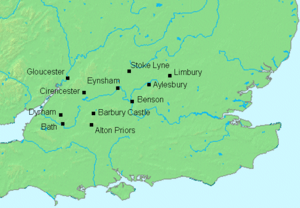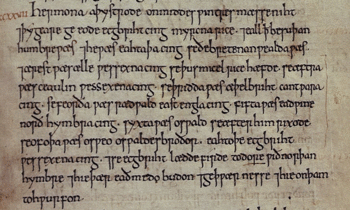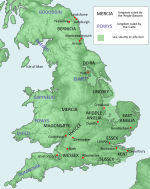Ceawlin of Wessex facts for kids
Quick facts for kids Ceawlin |
|
|---|---|
Ceawlin's name as it appears in the Anglo-Saxon Chronicle, as Ceaulin
|
|
| King of Wessex Bretwalda of southern Britain |
|
| Reign | 560–592 |
| Predecessor | Cynric |
| Successor | Ceol |
| Died | 593 |
| Issue | Cutha (possibly) Cuthwine |
| House | Wessex |
| Father | Cynric of Wessex or Creoda of Wessex |
Ceawlin (also spelled Ceaulin, Caelin and Celin) was a powerful King of Wessex who lived around the 500s. He might have been the son of Cynric of Wessex and the grandson of Cerdic of Wessex. These ancestors are said to have led the first group of Saxons to settle in the area that later became Wessex. Ceawlin was active during the last big push of the Anglo-Saxons into England. By the time he died, most of southern England was under Anglo-Saxon control, with very little left for the native Britons.
The exact dates and events of Ceawlin's life are a bit unclear. Old records like the Anglo-Saxon Chronicle tell us about his battles between 556 and 592. These records even mention the first battle between different groups of Anglo-Saxons. Under Ceawlin, Wessex gained a lot of land, though some of it was later lost to other Anglo-Saxon kingdoms. Ceawlin is also known as one of the eight "bretwaldas". This was a special title given to rulers who had a lot of power over southern Britain. We don't know exactly how much control Ceawlin had, but it was significant.
Ceawlin died in 593. He had been removed from power the year before, possibly by Ceol, who became the next king. Some old writings say he had two sons, Cutha and Cuthwine, but these family trees aren't always reliable.
Contents
Understanding Ceawlin's Time
The history of Britain after the Romans left (the sub-Roman period) is hard to piece together because there aren't many clear records. However, it seems that in the 400s, groups from mainland Europe like the Angles, Saxons, Jutes, and Frisians started raiding and then settling in Britain. They took over land in the east and south of England.
Around the year 500, the Britons won a big battle called Mons Badonicus. This stopped the Anglo-Saxon advance for about 50 years. But by 550, the Britons started losing ground again. Within 25 years, most of southern England was controlled by the invaders.
A monk named Gildas wrote about this time in the mid-500s. He mentioned a period of peace, which matches the gap in the Anglo-Saxon Chronicle's list of powerful kings called "bretwaldas". Ceawlin's time as king fits into this period of Anglo-Saxon expansion at the end of the 500s. Even with some unanswered questions, it's clear that Ceawlin was a very important leader in the final Anglo-Saxon takeover of southern Britain.
Old Records of Wessex
The two main written sources about the early history of Wessex are the Anglo-Saxon Chronicle and the West Saxon Genealogical Regnal List.
The Anglo-Saxon Chronicle
The Chronicle is a collection of yearly records put together around 890, during the time of King Alfred the Great of Wessex. It includes older information from even earlier records that no longer exist, and also from old stories that were passed down by word of mouth. The Chronicle says that the future "West Saxons" arrived in Britain in 495. It mentions Cerdic and his son, Cynric, landing at a place called Cerdices ora. The Chronicle has almost 20 entries describing Cerdic's battles and those of his family over the next hundred years. While these entries tell us most of what we know about Ceawlin, historians aren't always sure how accurate they are.
The West Saxon Genealogical Regnal List
This list names the rulers of Wessex and how long they reigned. Like the Chronicle, it was put together during Alfred the Great's time. Both sources were influenced by the desire to show a clear family line for the Kings of Wessex, tracing them back through Cerdic to a legendary ancestor named Gewis, who was said to be related to the god Woden. This was important for political reasons at the time, but it makes things confusing for historians today because there are many contradictions.
For example, the Chronicle says Cerdic arrived in 495. But if you add up the lengths of the reigns from the Regnal List, Cerdic's rule might have started in 532. This is a big difference! Historians can't be sure about either date.
The sources also disagree on how long Ceawlin ruled. The Chronicle says 32 years (from 560 to 592), but different versions of the Regnal List say 7 or 17 years. Historians now think his reign was likely shorter, perhaps from 581 to 588. The sources do agree that Ceawlin was the son of Cynric and usually say he was the father of Cuthwine.
Some historians even wonder if Ceawlin was truly a descendant of Cerdic. The names of some early Wessex leaders, including Ceawlin, don't sound like typical Germanic names. They might be British, which suggests that the family trees were changed later to connect everyone to Cerdic.
The term "West Saxon" wasn't used in the very early days. According to Bede's Ecclesiastical History of the English People, the people were called the Gewisse. The name "West Saxon" only appeared later, after the time of Cædwalla.
Wessex Expands Its Territory
Eventually, the kingdom of Wessex covered the southwest of England. The first steps of this expansion are not fully clear. Cerdic's landing seems to have been near the Isle of Wight. The old records say the island was conquered in 530. In 534, Cerdic died, and his son Cynric became king. The Chronicle adds that they gave the Isle of Wight to their nephews. However, Bede says the Isle of Wight was settled by Jutes, not Saxons, and archaeological findings tend to support Bede.
Later entries in the Chronicle describe some of the battles where the West Saxons gained their kingdom. Ceawlin's battles were not near the coast. They stretched along the Thames Valley and even further, reaching Surrey in the east and the mouth of the Severn in the west. Ceawlin was clearly a big part of the West Saxon expansion. The dates below are from the Chronicle, but remember they might be earlier than what historians now think is accurate.
556: Battle at Beran byrg
The first battle recorded for Ceawlin was in 556. He and his father, Cynric, fought the native Britons at a place called "Beran byrg". This place is now believed to be Barbury Castle, an old hill fort in Wiltshire, near Swindon. At this time, Cynric would have been the King of Wessex.
568: Battle of Wibbandun
The first battle Ceawlin fought as king is dated to 568. He and a person named Cutha fought against Æthelberht, the king of Kent. The record says they "drove him into Kent" and killed two leaders, Oslaf and Cnebba, at Wibbandun. The exact location of "Wibbandun" (which means "Wibba's Mount") is not known for sure. It was once thought to be Wimbledon, but that's now known to be wrong.
Some historians suggest it might be Wyboston, a village north-east of Bedford. This battle is important because it's the first recorded fight between different groups of Anglo-Saxons. Before this, the battles mentioned in the Chronicle were always between Anglo-Saxons and Britons. It's possible that Cutha was also a king, as there are other examples of two kings ruling together in Anglo-Saxon history.
571: Battle at Bedcanford
The record for 571 says: "Here Cuthwulf fought against the Britons at Bedcanford, and took four settlements: Limbury and Aylesbury, Benson and Eynsham; and in the same year he passed away." We don't know Cuthwulf's exact relationship to Ceawlin, but his name suggests he was part of the West Saxon royal family. The location of this battle is also unknown. It's interesting because it's surprising that an area so far east would still be controlled by Britons at this late date. One idea is that this battle was to take back land that the Britons had won earlier.
577: Battle at Lower Severn
The record for 577 states: "Here Cuthwine and Ceawlin fought against the Britons, and they killed three kings, Coinmail and Condidan and Farinmail, in the place which is called Dyrham, and took three cities: Gloucester and Cirencester and Bath." This is all we know about these British kings. Their names are very old, suggesting this record comes from a much older source. This battle was a key moment for the Saxons because by reaching the Bristol Channel, the West Saxons cut off the Britons in Wales from those in the south-west peninsula. Wessex probably lost this territory later to Penda of Mercia in 628.
When Ceawlin and Cuthwine took Bath, they might have found the old Roman baths still working. An old historian named Nennius described a "Hot Lake" in this area, saying people could bathe there and choose hot or cold water. Bede also described hot baths in a similar way.
Wansdyke, an old defensive wall made of earth, runs not far from Bath. It was likely built in the 400s or 500s, possibly by Ceawlin.
584: Battle at Fethan leag
Ceawlin's last recorded victory was in 584. The record says: "Here Ceawlin and Cutha fought against the Britons at the place which is named Fethan leag, and Cutha was killed; and Ceawlin took many towns and countless war-loot, and in anger he turned back to his own [territory]." This battle is thought to have happened in Oxfordshire.
The phrase "in anger he turned back to his own" might mean that Ceawlin didn't fully win the battle, or that the writer didn't record the full outcome. A king usually doesn't return "in anger" after a big victory. It's possible that Ceawlin's power over the southern Britons ended after this battle.
What is a Bretwalda?
Around 731, a monk named Bede wrote a book called the Ecclesiastical History of the English People. In it, he listed seven kings who, he said, held "imperium" (meaning "overlordship" or great power) over the other kingdoms south of the Humber. Bede named Ceawlin as the second on this list. He also made it clear that Ceawlin was not a Christian.
The Anglo-Saxon Chronicle, in an entry for 827, repeated Bede's list and added Egbert of Wessex. It also mentioned that these kings were known as "bretwalda", or "Britain-ruler". This word has been studied a lot, and it seems to mean a military leader who had power over other kings.
Bede said these kings had authority "south of the Humber River." While the exact area of control for early bretwaldas like Ceawlin is hard to know, Bede's list and Ceawlin's battle victories show he was a strong and successful leader. From his base in the upper Thames valley, he controlled much of the surrounding area and held power over the southern Britons for some time. However, Ceawlin couldn't always keep the northern lands he conquered. For example, Mercia later took much of the upper Thames valley, and some towns won in 571 later came under the control of Kent and Mercia.
Ceawlin is the second king on Bede's list. There's a long gap, maybe 50 years, between Ælle of Sussex, the first bretwalda, and Ceawlin. This gap might support the idea that there was a period of peace after the Britons won the battle of Mons Badonicus.
Æthelberht of Kent followed Ceawlin on the list of bretwaldas. It's possible their reigns overlapped a bit. Ceawlin's defeat in 592, probably by Ceol, might have been when Æthelberht became more powerful. Æthelberht was likely the most powerful Anglo-Saxon king by 597.
Wessex After Ceawlin
Ceawlin lost his throne in 592. The record for that year says: "Here there was great slaughter at Woden's Barrow, and Ceawlin was driven out." Woden's Barrow is an ancient burial mound now called Adam's Grave in Wiltshire. The record doesn't say who fought him. A medieval writer named William of Malmesbury said it was "the Angles and the British conspiring together." It might also have been Ceol, who became the next king of Wessex. According to the Anglo-Saxon Chronicle, Ceawlin died the next year. The record says: "Here Ceawlin and Cwichelm and Crida perished." We don't know much more about Cwichelm and Crida, but they might have been part of the Wessex royal family.
After Ceawlin's death, it's possible that the control of Wessex was split among different leaders. This split might have helped Æthelberht become the dominant king in southern England. However, the West Saxons remained strong militarily. The Chronicle and Bede record that they continued fighting against Essex and Sussex within 20 or 30 years of Ceawlin's death.
See also
 In Spanish: Ceawlin de Wessex para niños
In Spanish: Ceawlin de Wessex para niños




